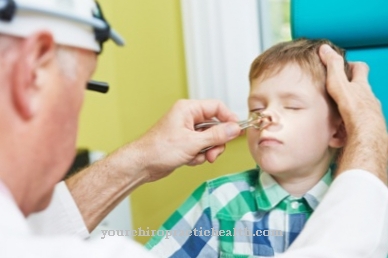The Strabology examines all types and effects of squint, a misalignment of both eyes to each other, which results from disturbances in the balance of the eye muscles. It is a special discipline in ophthalmology and includes prevention, diagnosis and therapy of strabismus diseases. It is practiced in eye clinics and most ophthalmological practices.
What is Strabology?
When squinting (strabismus), the lines of sight of the eyes do not coincide temporarily or permanently when a certain object is fixed. These malpositions can be very diverse in their severity and shape, but can be precisely determined using different optical methods.
The so-called squint angle gives detailed information about the extent of such a disease. In severe cases it is associated with massive functional visual impairments and is then considerably more than just an aesthetic or cosmetic problem. An estimated five to six percent of people in Germany are affected by strabismus. In many cases, strabismus is inherited, but it can also be acquired through health causes and accidents. Some forms are not pathological, but simply deviate from a normal state.
In an esophoria, the eye is squinted inwards, in an exophoria, outward. Hyperphoria means an upward squinting eye. The earlier the strabismus is treated in children, the better the visual impairment can be compensated. Strabismus is not infrequently underestimated, especially in young children. Often the chances of success of a treatment that only begins at school age are considerably limited. Squinting usually results in unilateral visual impairment.Significant disturbances in three-dimensional vision are also usually encountered. In many cases, surgery is necessary to effectively eliminate squinting weakness. The lines of sight of the affected eyes are corrected.
Most of the time, this posture correction takes place on the eye muscles. The squinting eye is straightened again. This is done either by shortening or lengthening the strands on the eyeball. It is also possible to shift the starting point of these strands. In children, the procedure is carried out under general anesthesia, but is usually associated with low risks. Often the external eye muscles are corrected. Further treatment of the visual impairment is necessary postoperatively, also in the spatial area. In most cases, the operation cannot make wearing glasses superfluous. Under normal conditions, the procedure in children requires a hospital stay of two to three days.
Treatments & therapies
Thanks to simple examinations, reliable statements can be made as early as infancy as to whether and how strabismus develops in the child. The corneal reflexes and the movements that follow them are assessed with a small flashlight.
The fundus reflexes also provide information about any strabismus that may develop. In addition to the apparatus-based methods in the ophthalmologist's practice, so-called free space examinations form an important basis for diagnosing strabismus. The patient's ability to perceive objects and light sources correctly can often be best assessed in the natural environment. In addition, the position of the eyes must always be examined in terms of distance and proximity. One of the most common examination procedures, the cover test, also takes place outdoors.
Any squint deviations near and far are determined by means of a prism bar and various color filters. This is also served by the so-called Maddox cross, which is equipped with a fixation light and allows an examination over a distance of five meters. The numerous devices used in free space have in common the requirement to be able to measure horizontal, vertical and rotational deviations in the viewing angle of the eyes. For a comprehensive diagnosis of the squint angle, around 180 measurements in various directions are necessary.
You can find your medication here
➔ Medicines for visual disturbances and eye complaintsDiagnosis & examination methods
The most common is what is known as latent strabismus (heterophoria), which mainly results from an overstrained eye and usually remains untreated. In these cases, the brain is often able to compensate for impaired vision by correcting deviating eye positions itself.
The concomitant strabismus (strabismus concomitans), which can appear in babies, and the paralysis strabismus (strabismus paralyticus) require medical intervention. Paralytic squint is often the result of inflammation or injury that paralyzes the muscles of the eye. With very strong squint, double vision occurs in many cases. Then the parallel position of the eyes is disturbed so much that the two visual impressions no longer merge into one image. Children try to compensate for this by using one eye less and the other more for it, which leads to pronounced visual impairment later on. This is why treating strabismus early in childhood is so important.
An operation can thus usually be avoided. For example, the doctor prescribes suitable glasses and individual eye training. In addition, the conservative method of occlusion therapy, in which both eyes are alternately taped with a plaster, is still widely used. In this way, the visually impaired eye is effectively trained to slowly adjust to the stronger one. If this project succeeds, the children will often have overcome their poor eyesight by the age of twelve and do not need to undergo eye surgery.
If the surgical intervention against the early childhood internal squint on the damaged eye muscles is necessary, the child's eyes can often look almost in the same direction again, but it is not uncommon for long-term defects in three-dimensional vision to remain.



























